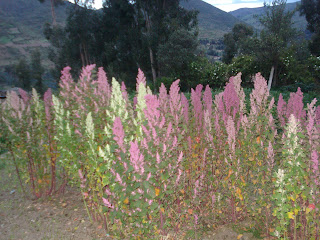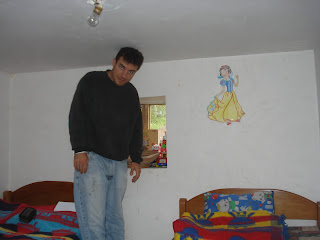Finally towards the end of our trip to Peru, we arrived at the Parque de la Papa, a park set up in collaboration between a group of indigenous villages and a few NGOs, with the aim of preserving the agrobiodiversity of the high Peruvian Andes. We received a musical welcome from costume-clad local residents and their impressive display of over 70 potato varieties:

After a brief explanation of the park's history and its geographical layout, we set out to see the sights. We were treated to warm baked potatoes served with local cheese and a sort of chimichurry sauce.
First we visited the potato introduction center. Here the park laboratory crew (all comprised of local peasants) receives in-vitro potato plantlets from CIP, the International Potato Center. The park's communities have an agreement with CIP whereby CIP repatriates potato varieties that the center had collected from the area decades ago and that have since been lost (because farmers stopped growing them). CIP offers these in-vitro plantlets, which also happen to be free from the viruses and fungi that inevitably accumulate in tuber-propagated crops, and the Parque de la Papa reintroduces them to the community. It is a great example of peasants and research centers working together. If the peasants and their ancestors hadn't created all these potato varieties, CIP wouldn't have been able to collect and use them. But if CIP hadn't collected them when they did, they would have been lost, because the short-term profit motive of farmers led them to abandon many of these varieties over the last few decades. As is, today the park houses something like 2000 potato varieties.
The park staff receives the plantlets in test tubes, and transplants them to pots in a sterile laboratory in the adobe shed at the right.
They then move these pots to the mesh-house at the left, which is kept free from pests and disease by a strict quarantine procedure whereby only certain people can enter, and they must change into lab clothes and disinfect themselves with quicklime in this anteroom.
The plants in the mesh-house produce a few tubers, and these are replanted to another, less sterile mesh-house for further multiplication.
In turn these pots produce more tubers, which are moved to communal fields in each village for another round of multiplication. Finally, individual farmers can take varieties they like from this communal field for planting at their house. The flow also goes in the other direction, as farmers and communal village fields donate interesting varieties to the multiplication center for distribution.
Later on we went up higher (to more than 4000 m altitude) and saw a little hamlet where members of a certain village (there are six villages contained in the park) sow Andean tubers. Things are so chilly up here that the donkeys have evolved to be shaggy and warm.
Here is a big reservoir that they've dammed to serve the intricate irrigation system that runs down the hills below.
The hillside fields here in the background are not irrigated, though. They farm them one or a few years, then let them regenerate for seven years or so. The whole hamlet coordinates this such that they are all planting their crops in just one patch any given year.

They have potatoes adapted to very high altitudes

Oca, which we call ibia in Colombia.
Mashua or cubio.
And even wild potato species that grow in uncultivated areas
We also visited a women's enterprise center, where they fabricate cosmetics from local herbs.
Here is a batch of soap in process of packaging.
They also package powdered coca leaves in teabags.
In all of the villages we passed through in the park, I was impressed by their adobe construction and mud plaster, just like my house back in Colombia. It appears there is a pool of local artisans who even do designs and figures in the plaster.
We also saw some women and men at work spinning wool (both sheep and alpaca, I believe) and weaving things, from these narrow bands to large shawls.
I also liked seeing the local pigs. They are understandably woolly, but it's also impressive to see the long, strong legs and efficient gait of a peasant pig that lives by semi-independent foraging, as opposed to the stall-fattened pigs most of us know in the modern age.
Our formal tour was topped off with a delicious meal at the park's tourist restaurant. A cooperative of local women served us alpaca in uchuva sauce, cooked quinoa, potato, and local greens.
This was accompanied by a potato and quinoa soup,
And a sort of vinegary juice made from a local herb.
All the dishes used in the restaurant are locally-made pottery with designs and captions of different potato varieties found in the park.
Our visit was fascinating, though my two colleagues and I were woozy and weak through most of it due to the effects of gastric problems and the ridiculously high altitude. So it was a relief to arrive at the houses we'd be staying at that night. They too had decorated mud plaster, though the interior decorations were not bas-reliefs but rather painted words and animals.
Here was the room I had a nap in that afternoon.
In the house's patio was the ubiquitous chaquitaclla, the foot-driven plow/shovel instrument indigenous Peruvian farmers use in the highland areas.
The people hosting us were Quechua-speaking natives, and only a few spoke Spanish. They didn't introduce themselves as indigenous people but rather as peasants, and indeed, aside from the different language, many of their practices, their ways of organizing space, their homes, their fields, even their landscape, were very similar to the highland peasant areas of Boyaca, Colombia. They don't deny that they are indigenous, and they maintain the pre-Spanish cosmovision of mountain spirits and community between humans and nature. But I guess that in a region where everyone is indigenous, the description "indigenous" doesn't say much, while "peasant" says more about how you live your day-to-day life.
Here I am in the low 2nd-floor corridor of the house I was to sleep in that night.
I of course did a fair amount of nosing about the local house-gardens. The houses are at a lower altitude ("only" 3500 masl) than the drier, highland tuber row crops we saw above. The house-gardens are planted more densely, managed more intensively, and generally everything is much greener.
There were fields of fava beans and barley, both mixed and solo, that were used mainly not for their grains but to cut fresh as animal feed.
Here is a barly plot that has been cut little by little as feed. To the left is a new planting of quinoa.
Here is some alfalfa, another feed crop that is common in this region, but that is inexplicably absent from most of highland Colombia.
What is all this feed for? There certainly aren't many cattle around, few sheep, and the alpacas are all pasturing far away in the high heaths. The answer is one of the most important animals domesticated in America: the guinea pig. One family I visited had a shed just for these little critters.
But I think most families just keep them in a corner of the kitchen, where they can readily feed them scraps.
Here are some filmed exploits of these silly little creatures.
This rascal was my favorite, all disheveled.
Here is the adobe house amid non-native pines and eucalyptus trees. Again, a scene that could be straight from central Colombia.
There is a garden of different herbs and medicines.
And a few plants of yacon, a sunflower (and Jerusalem artichoke) relative that, like its North American tuberous cousin, produces an edible root full in fact not of starch but of inulin, a long-chain carbohydrate that the human body can't digest. As such, yacon is used in many processed foods as a source of soluble fiber and as a mild sweetener that doesn't hurt diabetics.
In the evening I took this photo of twilit quinoa (or maybe kaniwa amaranth, which looks very similar).

As night fell, my hosts treated me to toasted corn and tea.
The kids took a picture of me looking silly in this special occasion attire.
Then the host mother gave me a delicious quinoa soup. Again, save the quinoa, which we hardly use in Boyaca, the flavor and other components were very similar to what I know from Colombia.
The kids even use quinoa for their school projects. Look:

Here's me again in a tiny room.

But lest I or any of the local Quechua inhabitants every think we're too big and lose sight of our minor place in the world, these ancient abandoned terraces are always present, watching over everything and reminding us that many have come before us and left their mark on the world with their work.
This is perhaps the major lesson gleaned from my whole visit to Peru, where the past is always present (it's not even past!). We are all part of a history that is unfathomably deep. We can and should work hard and be inspired by others that do so, but never make the mistake of becoming centered on how great one person or even one generation is. We should never forget all that have gone before us, because they have much to teach.









































No comments:
Post a Comment